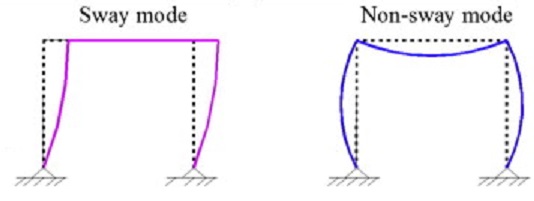🕑 Reading time: 1 minute
A frame is considered to be non-sway (braced) if it is sufficiently braced by lateral bracing elements like structural walls. On the other hand, frames that provide lateral resistance only through columns are considered to be sway frames (unbraced). ACI 318-19 can be used as a reference to distinguish between sway and non-sway frames.
It should be noted that purely sway and non-sway frames rarely exist in practice, hence, the design should be prepared based on the requirements. For instance, the designer should decide in advance if the bracing provided by shear walls, elevators, utility shafts, stairwells, or other elements would be sufficient to limit the structure against significant sway effects. It is possible that a particular storey in a structure could be sway while another is non-sway.
How to Distinguish Sway (braced) and Non-sway (unbraced) frames as per ACI 318-19?
ACI 318-19, section 6.6.4.3 states that a structure is considered to be non-sway (braced) if one of the following conditions are satisfied:
- If the increased end moments of columns due to the second-order effect is not greater than 5% of the first order end moments.
- When a stability index (Q) does not surpass 0.05. The stability index can be calculated with the help of Equation-1:

where:

If the conditions mentioned above are not met, the frame is considered to be a sway (unbraced). The factors that make frame to sway laterally are:
- Eccentric loading (unsymmetrical loading)
- Non-uniform sections of the members
- Presence of horizontal loading on a column of the frame
- Different end conditions of the columns of the frame
- Settlement of the supports of the frame

Differences between sway (braced) and non-sway (unbraced) frames can be summarized in Table-1:
Table-1: Differences between Sway Frames and Non-sway Frames
| Sway (braced) Frames | Non-sway (unbraced) Frames |
| Sway frames do not have adequate stiffness against in-plane horizontal forces, hence, additional forces or moments arising from horizontal displacements should be accounted for in the analysis | Non-sway frame response to in-plane horizontal forces is sufficiently stiff to neglect any additional forces or moments arising from horizontal displacements |
| The structure is symmetric, and loading is symmetric | Loading is asymmetric |
| It has only a rotational degree of freedom, and translational degree of freedom does not exist | It has in-plane displacements due to asymmetrical loading, different length of supports, and/or different moment of inertia |
| Joints change their positions due to deformation | Joints do not change their position due to deformation |
| Second-order analysis should be used | First-order analysis should always be used for the analysis of non-sway frame |
FAQs
A frame is considered to be non-sway (braced) if it is sufficiently braced by lateral bracing elements like structural walls. On the other hand, frames that provide lateral resistance only through columns are considered to be sway frames (unbraced). ACI 318-19 can be used as a reference to distinguish between sway and non-sway frames.
Some of the reasons for sway in frames are:
Side sway is any considerable lateral movement of the top of a vertical member relative to its bottom. It is also known as lateral drift.
Read more
What are the types of frame structures?


